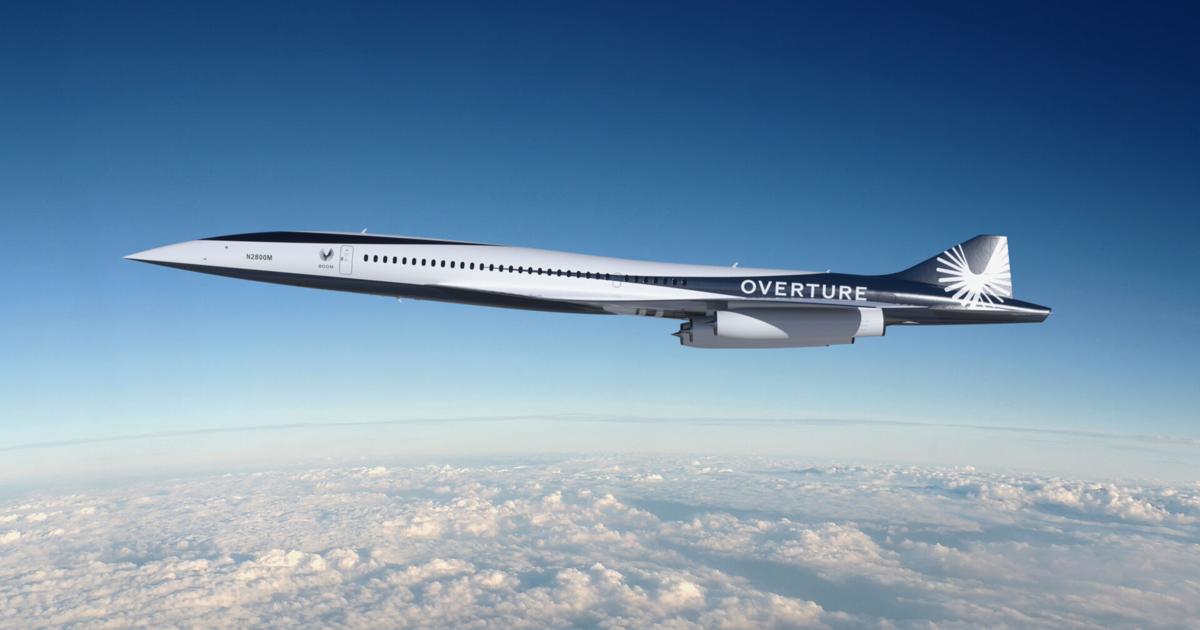A layer of the Boom Supersonic-NASA collaboration was peeled open last week with a study concluding that potential supersonic passenger markets exist in about 50 established routes.
NASA did not specify the routes in its Aug. 22 blog.
The space agency is investigating the business case for supersonic passenger air travel aboard aircraft that could theoretically travel between Mach 2 and Mach 4 (1,535 to 3,045 mph at sea level).
By comparison, large commercial airliners cruise at roughly 600 mph — or about 80% the speed of sound.
Since supersonic flight over land is prohibited in the United States and most countries, the NASA findings addressed transoceanic travel, including high-volume North Atlantic routes and those crossing the Pacific.
People are also reading…
Boom officials projected its Overture aircraft could serve at least 600 existing international flights when it announced plans for a $500 million “superfactory” at Piedmont Triad International Airport in Greensboro. Boom projects having at least 1,761 jobs when the factory is at full production capacity in 2030.
Overture is being designed to carry 65 to 80 passengers at Mach 1.7 over water — or twice the speed of today’s fastest commercial aircraft — with a range of 4,250 nautical miles.
At those speeds, flying from Miami to London in just under five hours and Los Angeles to Honolulu in three hours are among the possibilities, Boom has said.
NASA’s Quesst mission, with its X-59 “quiet supersonic aircraft, aims to provide data to regulators that would help change the overland supersonic flight rules.”
“These new studies will both refresh those looks at technology roadmaps and identify additional research needs for a broader high-speed range,” said Lori Ozoroski, a project manager for NASA’s Commercial Supersonic Technology project.
Taking flight
NASA said its Advanced Air Vehicles program is progressing to the next phase of high-speed travel research, which includes issuing two 12-month contracts for companies to develop concept designs and technology roadmaps.
The roadmaps will explore air travel possibilities, outline risks and challenges and identify needed technologies to make Mach 2-plus travel a reality.
Boeing is leading the first team, with partners that include Exosonic, GE Aerospace, Georgia Tech Aerospace Systems Design Laboratory, Rolls-Royce North American Technologies and others.
Meanwhile, Northrop Grumman Aeronautics Systems is directing the second team, with partners Blue Ridge Research and Consulting, Boom Supersonic and Rolls-Royce North American Technologies.
Boom and Northrop Grumman are also collaborating “on a special mission variant” of Overture after ongoing identification and investigation of use cases that will benefit the U.S. Defense Department.
“Time is a strategic advantage in high consequence scenarios, from emergency evacuations to disaster response,” said Blake Scholl, Boom’s chief executive and founder, in a statement. “This collaboration between Boom and Northrop Grumman unlocks the potential for Overture to provide the U.S. and our allies with an unmatched high-speed capability when and where it’s most needed.”
NASA said the Boeing and the Northrop Grumman teams will develop roadmap elements to include airframe, power, propulsion, thermal management and composite materials that can hold up under high-supersonic speeds.
They also will create non-proprietary designs for concept vehicles.
Once the industry engagement phase is completed, NASA and its partners will decide whether to continue the research with their own investments.
“The design concepts and technology roadmaps are really important to have in our hands when the companies are finished,” said Mary Jo Long-Davis, a manager of NASA’s Hypersonic Technology Project. “We are also collectively conscious of the need to account for safety, efficiency, economic and societal considerations. It’s important to innovate responsibly so we return benefits to travelers and do no harm to the environment.”
Overture’s role
Overture is expected to be the first large commercial aircraft to be net-zero carbon from Day One, running on 100% sustainable aviation fuel.
Boom’s XB-1, a demonstrator aircraft, was rolled out in 2020 and is being prepped for its first flight in Mojave, Calif.
According to Boom executive Kathy Savitt, the Overture timeline will go like this: beginning equipment installation in 2024, assembly in 2025, first rollout in 2026, first test flight in 2027, Federal Aviation Administration certification in 2029 and then first passenger flights later in 2029.
Kevin Baker, PTI’s executive director, said construction of the 400,000-square-foot facility is expected to be completed in the second quarter of 2024.
Overture will be powered by four wing-mounted engines that enable the airliner to cruise at Mach 1.7 over water and just under Mach 1 over land.
Boom said the four-engine design reduces noise while decreasing costs for airline operators.
Overture’s contoured fuselage has a larger diameter toward the front of the aircraft and a smaller diameter toward the rear. Boom has applied this design technique to minimize drag and maximize fuel efficiency at supersonic speeds.
“The aircraft’s gull wings are sculpted to enhance supersonic performance, as well as improve subsonic and transonic handling,” Boom has said. “Importantly, the wing shaping also helps ensure safety and stability at any speed.”
rcraver@wsjournal.com
336-727-7376
@rcraverWSJ

